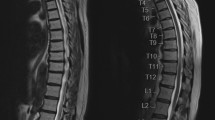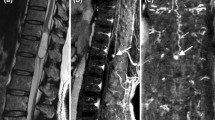Abstract
Purpose
The aim of this study was to evaluate the usefulness of three-dimensional T1-weighted spoiled gradient-recalled echo (3D T1-GRE) images for the preoperative anatomical evaluation of lumbosacral lipoma, thick filum terminale, and myelomeningocele as a means of compensating for the drawbacks of 3D heavily T2-weighted (3D hT2-W) images.
Methods
Nine patients with lumbosacral lipomas, one patient with tight filum terminale, and five patients with myelomeningoceles were included in this study. 3D T1-GRE images were compared with 3D hT2-W images or conventional magnetic resonance images in terms of delineation of lipomas and other structures in the patients with lipomas and tight filum terminale. For patients with myelomeningoceles, 3D T1-GRE images were compared with 3D hT2-W images in terms of artifacts in the cerebrospinal fluid (CSF) space.
Results
The 3D T1-GRE images demonstrated lipomas with good contrast to the spinal cord and CSF space and more clearly delineated the anatomical relationship between lipomas and these structures than did the 3D hT2-W images. The 3D T1-GRE images delineated dural defects through which extradural lipomas penetrated into the intradural space. The 3D T1-GRE images also demonstrated the presence or absence of lipomas in the filum terminale and the absence of artifact in the myelomeningoceles. Furthermore, they were useful for differentiating artifacts observed on the 3D hT2-W images from nerve elements.
Conclusions
The complementary use of 3D T1-GRE and 3D hT2-W images may compensate for the drawbacks of 3D hT2-W images and may eventually improve lesion visualization and surgical decision making.






Similar content being viewed by others
References
Aleman J, Jokura H, Higano S, Akabane A, Shirane R, Yoshimoto T (2001) Value of constructive interference in steady-state three-dimensional, Fourier transformation magnetic resonance imaging for the neuroendoscopic treatment of hydrocephalus and intracranial cysts. Neurosurgery 48:1291–1295
Arai H, Sato K, Okuda O, Miyajima M, Hishii M, Nakanishi H, Ishii H (2001) Surgical experience of 120 patients with lumbosacral lipomas. Acta Neurochir (Wien) 143:857–864
Bao N, Chen ZH, Gu S, Chen QM, Jin HM, Shi CR (2007) Tight filum terminale syndrome in children: analysis based on positioning of the conus and absence or presence of lumbosacral lipoma. Childs Nerv Syst 23:1129–1134
Baskaran V, Pereles FS, Russell EJ, Georganos SA, Shaibani A, Spero KA, Krupinski EA, Zhang A, Finn JP (2003) Myelographic MR imaging of the cervical spine with a 3D true fast imaging with steady-state precession technique: initial experience. Radiology 227:585–592
Blount JP, Elton S (2001) Spinal lipomas. Neurosurg Focus 10:e3
Brant-Zawadzki M, Gillan GD, Nitz WR (1992) MP RAGE: a three-dimensional, T1-weighted, gradient-echo sequence—initial experience in the brain. Radiology 182:769–775
Casselman JW, Kuhweide R, Deimling M, Ampe W, Dehaene I, Meeus L (1993) Constructive interference in steady state-3DFT MR imaging of the inner ear and cerebellopontine angle. AJNR Am J Neuroradiol 14:47–57
Chapman PH (1982) Congenital intraspinal lipomas: anatomic considerations and surgical treatment. Childs Brain 9:37–47
Cornips EM, Vereijken IM, Beuls EA, Weber JW, Soudant DL, van Rhijn LW, Callewaert PR, Vles JS (2012) Clinical characteristics and surgical outcome in 25 cases of childhood tight filum syndrome. Eur J Paediatr Neurol 16:103–117
Finn MA, Walker ML (2007) Spinal lipomas: clinical spectrum, embryology, and treatment. Neurosurg Focus 23:E10
Hashiguchi K, Morioka T, Fukui K, Miyagi Y, Mihara F, Yoshiura T, Nagata S, Sasaki T (2005) Usefulness of constructive interference in steady-state magnetic resonance imaging in the presurgical examination for lumbosacral lipoma. J Neurosurg 103:537–543
Hashiguchi K, Morioka T, Samura K, Yoshida F, Miyagi Y, Nagata S, Kokubo T, Yoshiura T, Sasaki T (2008) Holocord hydrosyringomyelia with terminal myelocystocele revealed by constructive interference in steady-state MR imaging. Pediatr Neurosurg 44:509–512
Hashiguchi K, Morioka T, Yoshida F, Miyagi Y, Mihara F, Yoshiura T, Nagata S, Sasaki T (2007) Feasibility and limitation of constructive interference in steady-state (CISS) MR imaging in neonates with lumbosacral myeloschisis. Neuroradiology 49:579–585
Held P, Fellner C, Fellner F, Seitz J, Graf S, Hilbert M, Strutz J (1997) MRI of inner ear and facial nerve pathology using 3D MP-RAGE and 3D CISS sequences. Br J Radiol 70:558–566
Hoffman HJ, Hendrick EB, Humphreys RP (1976) The tethered spinal cord: its protean manifestations, diagnosis and surgical correction. Childs Brain 2:145–155
Lane JI, Ward H, Witte RJ, Bernstein MA, Driscoll CL (2004) 3-T imaging of the cochlear nerve and labyrinth in cochlear-implant candidates: 3D fast recovery fast spin-echo versus 3D constructive interference in the steady state techniques. AJNR Am J Neuroradiol 25:618–622
Miyagi Y, Morioka T, Yoshida F, Hashiguchi K, Inoue D, Mizoguchi M, Shono T, Nagata S, Sasaki T (2007) Unusual MR presentation of occult spinal dysraphism with lumbosacral lipoma and dermoid cyst. Childs Nerv Syst 23:109–112
Morioka T, Hashiguchi K, Mukae N, Sayama T, Sasaki T (2010) Neurosurgical management of patients with lumbosacral myeloschisis. Neurol Med Chir (Tokyo) 50:870–876
Morioka T, Hashiguchi K, Yoshida F, Matsumoto K, Miyagi Y, Nagata S, Yoshiura T, Masumoto K, Taguchi T, Sasaki T (2008) Neurosurgical management of occult spinal dysraphism associated with OEIS complex. Childs Nerv Syst 24:723–729
Morioka T, Hashiguchi K, Yoshida F, Nagata S, Miyagi Y, Mihara F, Sasaki T (2007) Dynamic morphological changes in lumbosacral lipoma during the first months of life revealed by constructive interference in steady-state (CISS) MR imaging. Childs Nerv Syst 23:415–420
Pierre-Kahn A, Lacombe J, Pichon J, Giudicelli Y, Renier D, Sainte-Rose C, Perrigot M, Hirsch JF (1986) Intraspinal lipomas with spina bifida. Prognosis and treatment in 73 cases. J Neurosurg 65:756–761
Pierre-Kahn A, Zerah M, Renier D, Cinalli G, Sainte-Rose C, Lellouch-Tubiana A, Brunelle F, Le Merrer M, Giudicelli Y, Pichon J, Kleinknecht B, Nataf F (1997) Congenital lumbosacral lipomas. Childs Nerv Syst 13:298–334
Ramli N, Cooper A, Jaspan T (2001) High resolution CISS imaging of the spine. Br J Radiol 74:862–873
Ross JS (1992) MR imaging of the cervical spine: techniques for two- and three-dimensional imaging. AJR Am J Roentgenol 159:779–786
Samura K, Morioka T, Hashiguchi K, Yoshida F, Miyagi Y, Yoshiura T, Suzuki SO, Sasaki T (2009) Coexistence of a human tail and congenital dermal sinus associated with lumbosacral lipoma. Childs Nerv Syst 25:137–141
Tanitame K, Tanitame N, Tani C, Ishikawa M, Takasu M, Date S, Otani K, Awai K (2011) Evaluation of lumber nerve root compression using thin-slice thickness coronal magnetic resonance imaging: three-dimensional fat-suppressed multi-shot balanced non-steady-state free precession versus three-dimensional T1-weighted spoiled gradient-recalled echo. Jpn J Radiol 29:623–629
Tokunaga S, Morioka T, Hashiguchi K, Samura K, Yoshida F, Miyagi Y, Yoshiura T, Yamanouchi T, Sasaki T (2009) Double lumbosacral lipomas of the dorsal and filar types associated with OEIS complex: case report. Neurol Med Chir (Tokyo) 49:487–490
Yundt KD, Park TS, Kaufman BA (1997) Normal diameter of filum terminale in children: in vivo measurement. Pediatr Neurosurg 27:257–259
Conflict of interest
The authors declare that they have no conflict of interest.
Author information
Authors and Affiliations
Corresponding author
Rights and permissions
About this article
Cite this article
Murakami, N., Morioka, T., Hashiguchi, K. et al. Usefulness of three-dimensional T1-weighted spoiled gradient-recalled echo and three-dimensional heavily T2-weighted images in preoperative evaluation of spinal dysraphism. Childs Nerv Syst 29, 1905–1914 (2013). https://doi.org/10.1007/s00381-013-2140-6
Received:
Accepted:
Published:
Issue Date:
DOI: https://doi.org/10.1007/s00381-013-2140-6




